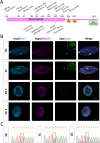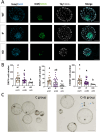SMC2 ablation impairs bovine embryo development shortly after blastocyst hatching
- PMID: 39231091
- PMCID: PMC11466199
- DOI: 10.1530/REP-24-0211
SMC2 ablation impairs bovine embryo development shortly after blastocyst hatching
Abstract
In brief: Bovine embryos lacking SMC2 (a core component of condensins I and II) are unable to survive maternal recognition of pregnancy. SMC2 KO embryos are able to form blastocysts, exhibiting a reduced cell proliferation ability, and arrest their development shortly after hatching.
Abstract: Condensins are large protein complexes required for chromosome assembly and segregation during mitosis and meiosis. Mouse or bovine embryos lacking SMC2 (a core component of condensins I and II) do not complete development to term, but it is unknown when they arrest their development. Herein, we have assessed the developmental ability of bovine embryos lacking SMC2 due to a naturally occurring mutation termed HH3 (Holstein Haplotype 3) or by CRISPR-mediated gene ablation. To determine if embryos homozygous for the HH3 allele survive to maternal recognition of pregnancy, embryonic day (E)14 embryos were flushed from superovulated carrier cows inseminated with a carrier bull. Mendelian inheritance of the HH3 allele was observed at E14 conceptuses but conceptuses homozygous for HH3 failed to achieve elongation and lacked an embryonic disc. To assess the consequence of the ablation of condensins I and II at earlier developmental stages, SMC2 KO bovine embryos were generated in vitro using CRISPR technology. SMC2 KO embryos were able to form blastocysts but exhibited reduced cell proliferation as evidenced by a significantly lower number of total, trophectoderm (CDX2+), and inner cell mass (SOX2+) cells at Day (D) 8 post-fertilization compared to their WT counterparts and were unable to survive to D12 in vitro. SMC2 ablation did not alter relative telomere length at D8, D12, or E14. In conclusion, condensins I and II are required for blastomere mitosis during early development, and embryos lacking those complexes arrest their development shortly after blastocyst hatching.
Conflict of interest statement
The authors declare that there is no conflict of interest that could be perceived as prejudicing the impartiality of the study reported.
Figures



Similar articles
-
HH5 double-carrier embryos fail to progress through early conceptus elongation.J Dairy Sci. 2024 Aug;107(8):6371-6382. doi: 10.3168/jds.2023-24482. Epub 2024 Apr 19. J Dairy Sci. 2024. PMID: 38642647
-
PPARG is dispensable for bovine embryo development up to tubular stages†.Biol Reprod. 2024 Sep 14;111(3):557-566. doi: 10.1093/biolre/ioae083. Biol Reprod. 2024. PMID: 38832705 Free PMC article.
-
TEAD4 regulates trophectoderm differentiation upstream of CDX2 in a GATA3-independent manner in the human preimplantation embryo.Hum Reprod. 2022 Jul 30;37(8):1760-1773. doi: 10.1093/humrep/deac138. Hum Reprod. 2022. PMID: 35700449
-
Bioactive supplements influencing bovine in vitro embryo development.J Anim Sci. 2022 Jul 1;100(7):skac091. doi: 10.1093/jas/skac091. J Anim Sci. 2022. PMID: 35772761 Free PMC article. Review.
-
The cytogenetic constitution of human blastocysts: insights from comprehensive chromosome screening strategies.Hum Reprod Update. 2019 Jan 1;25(1):15-33. doi: 10.1093/humupd/dmy036. Hum Reprod Update. 2019. PMID: 30395265 Review.
References
-
- Bermejo-Alvarez P Ramos-Ibeas P Park KE Powell AP Vansandt L Derek B Ramirez MA Gutierrez-Adan A & Telugu BP. 2015Tet-mediated imprinting erasure in h19 locus following reprogramming of spermatogonial stem cells to induced pluripotent stem cells. Scientific Reports 513691. (10.1038/srep13691) - DOI - PMC - PubMed
-
- Callicott RJ & Womack JE. 2006Real-time pcr assay for measurement of mouse telomeres. Comparative Medicine 5617–22. - PubMed
MeSH terms
LinkOut - more resources
Full Text Sources
Research Materials

